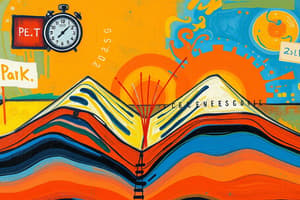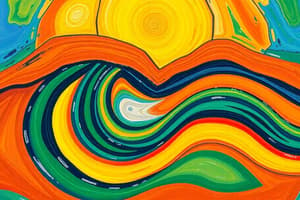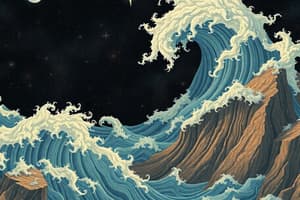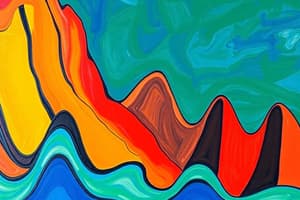Podcast
Questions and Answers
A block opposite you across a strike-slip fault moves to your right. What type of fault is this?
A block opposite you across a strike-slip fault moves to your right. What type of fault is this?
- Sinistral fault
- Normal fault
- Reverse fault
- Dextral fault (correct)
Which type of fault results in a vertical displacement of the ground due to the upward movement of the hanging wall?
Which type of fault results in a vertical displacement of the ground due to the upward movement of the hanging wall?
- Strike-slip fault
- Sinistral fault
- Normal fault
- Reverse fault (correct)
During liquefaction, what causes the increase in pore water pressure?
During liquefaction, what causes the increase in pore water pressure?
- Increase in the spaces between grains
- Decrease in sediment vibration
- Decrease in the weight of overlying material
- Compaction of sediments and squeezing out of fluids (correct)
What visual phenomenon is associated with liquefaction at depth?
What visual phenomenon is associated with liquefaction at depth?
Which of the following is NOT a typical trigger for landslides?
Which of the following is NOT a typical trigger for landslides?
What is the primary cause of creep?
What is the primary cause of creep?
What process causes tsunami waves to increase in height as they approach the shore?
What process causes tsunami waves to increase in height as they approach the shore?
What is the MOST common trigger for tsunamis?
What is the MOST common trigger for tsunamis?
Which of the following best explains why the edges of tectonic plates are prone to earthquakes?
Which of the following best explains why the edges of tectonic plates are prone to earthquakes?
Why does ground shaking cause the most earthquake damage to structures?
Why does ground shaking cause the most earthquake damage to structures?
How do Love waves differ from other seismic waves, and what is their primary motion?
How do Love waves differ from other seismic waves, and what is their primary motion?
How do P-waves and S-waves differ in terms of speed and motion?
How do P-waves and S-waves differ in terms of speed and motion?
Why are building codes important in areas prone to earthquakes?
Why are building codes important in areas prone to earthquakes?
What is 'ground rupture,' and how does it manifest during an earthquake?
What is 'ground rupture,' and how does it manifest during an earthquake?
What is the relationship between earthquake frequency and building damage?
What is the relationship between earthquake frequency and building damage?
Besides ground shaking, what secondary hazards can earthquakes trigger?
Besides ground shaking, what secondary hazards can earthquakes trigger?
Flashcards
Strike-slip Faults
Strike-slip Faults
Faults that displace rock horizontally; movement is either to the left (sinistral) or right (dextral).
Normal Fault
Normal Fault
Hanging wall moves downward relative to the footwall due to extension.
Reverse/Thrust Fault
Reverse/Thrust Fault
Hanging wall moves upward relative to the footwall typically due to compression.
Liquefaction
Liquefaction
Signup and view all the flashcards
Sand Boils
Sand Boils
Signup and view all the flashcards
Mass Wasting (Landslide)
Mass Wasting (Landslide)
Signup and view all the flashcards
Creep
Creep
Signup and view all the flashcards
Tsunami
Tsunami
Signup and view all the flashcards
Earthquake
Earthquake
Signup and view all the flashcards
Tectonic Plates
Tectonic Plates
Signup and view all the flashcards
Body Waves
Body Waves
Signup and view all the flashcards
Primary (P) Waves
Primary (P) Waves
Signup and view all the flashcards
Secondary (S) Waves
Secondary (S) Waves
Signup and view all the flashcards
Surface Waves
Surface Waves
Signup and view all the flashcards
Earthquake Severity
Earthquake Severity
Signup and view all the flashcards
Ground Rupture
Ground Rupture
Signup and view all the flashcards
Study Notes
- An earthquake is a phenomenon caused by the sudden and rapid movement of large volumes of rock along fractures on the surface of the earth called faults.
- The outermost shell of the earth consists of tectonic plates, which include the crust and the uppermost mantle.
- Tectonic plates are massive and irregularly shaped slabs of rock.
- The edges of tectonic plates get stuck as the plates continue to move due to their roughness.
- Seismic waves radiate energy in all directions through rocks beneath the earth, creating the shaking felt on the surface.
- The two main types of seismic waves are body waves and surface waves.
- Body waves travel through the interior of the earth.
Primary Waves
- Primary (P) waves are the first to reach the surface, causing the ground to move back and forth in the direction of travel.
- The shaking from P waves is light, or sometimes not felt.
Secondary Waves
- Secondary (S) waves are body waves that vibrate perpendicular to the direction of travel, resulting in an up-and-down motion.
- S waves move slower but shake the ground more strongly than P waves.
- Surface waves are trapped near the surface.
Love Waves
- Love waves are surface waves with horizontal motion perpendicular to their direction of travel.
Rayleigh Waves
- Rayleigh waves shake the ground in a rotational manner without transverse motion.
- The severity of an earthquake is measured by its magnitude (energy released) and intensity (effects on people and structures).
- Frequency is the number of times a movement such as ground shaking is repeated within a certain amount of time.
- High frequency earthquakes affect small buildings more than tall buildings.
- Ground shaking is the primary cause of earthquake damage, leading to the collapse of structures and potential casualties.
- Flash floods can occur if ground shaking breaks water dams.
- Fire is a secondary hazard triggered by damage to electric and gas lines.
- Ground shaking can also cause landslides and liquefaction.
- Building codes set standards for building construction to ensure structures are built properly.
- Ground rupture is the visible breaking and displacement of the Earth's surface along the trace of a fault.
- Ground rupture can involve vertical, lateral, or combined movements, depending on the fault type.
Strike-Slip Faults
- Strike-slip faults are vertical or near-vertical faults that displace rock horizontally.
- If the block opposite you moves left, it is a sinistral (left-lateral) fault.
- If the block moves right, it is a dextral (right-lateral) fault.
- Normal faults involve downward movement of the hanging wall relative to the footwall.
- Reverse or thrust faults move the hanging wall up.
- Dip-slip faults cause vertical displacement of the ground.
- Liquefaction occurs when the ground loses stiffness and behaves like a liquid during earthquakes.
- During shaking, grains vibrate, and undergo compaction where sediments are compressed, squeezing out fluids.
- Pore water pressure increases as spaces between sediment grains decrease.
- Liquefaction happens when the pore water pressure equals the weight of the overlying material.
- Sand boils involve geysers of sand and water shooting from the ground due to liquefaction at depth.
- Mass wasting, also known as a landslide, is the downslope movement of rocks or sediments due to gravity.
- Landslides follow weathering and removal of rock or debris.
- Landslides are triggered by factors such as rain, oversteepened slopes, removal of vegetation, and earthquakes.
- Creep is the gradual, almost imperceptible downslope displacement of rock or soil due to strain buildup.
- Factors affecting earthquake-induced landslides include earthquake strength, distance from the fault, topography, climate, rock/soil characteristics, and human modifications.
- A tsunami is a series of waves caused by water displacement, often from earthquakes or landslides.
- The Japanese word "tsunami" translates to "harbor wave."
- Earthquakes beneath the sea cause the water above to move upwards and produce tsunamis.
- Tsunami waves grow in height as they move into shallower depths, a process called wave shoaling, and approach the shore.
- Tsunamis often originate from earthquakes in subduction zones.
- Subduction zones are convergent boundaries where tectonic plates collide, and one plate descends beneath another due to temperature differences.
- Tsunamis can be local or regional.
- Local tsunamis originate nearby, affecting coasts within 100 km or less than an hour's travel time.
- Regional tsunamis affect a wide geographical area, typically within 1,000 km or within 1-3 hours of wave travel.
- Tsunamis can be predicted, but their exact damage cannot be foreseen.
Studying That Suits You
Use AI to generate personalized quizzes and flashcards to suit your learning preferences.




